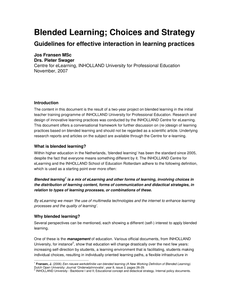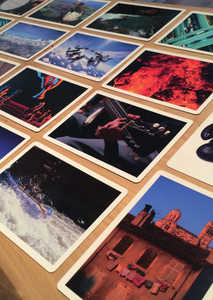Dit paper is het eindproduct van leerarrangement 1 (Zin in Leren) van de HBO masteropleiding Leren en Innoveren. Het is een literatuurstudie naar blended learning en hoe blended learning kan bijdragen aan een beter leerresultaat van de student.
DOCUMENT

The content in this document is the result of a two-year project on blended learning in the initial teacher training programme of INHOLLAND University for Professional Education. Research and design of innovative learning practices was conducted by the INHOLLAND Centre for eLearning. This document offers a conversational framework for further discussion on (re-)design of learning practices based on blended learning and should not be regarded as a scientific article. Underlying research reports and articles on the subject are available through the Centre for e-learning.
DOCUMENT

Contemporary education increasingly involves a blended learning environment, which consists of a combination of offline and online delivery methods. Blended learning environments can motivate students to learn, but designing motivating blended learning environments is challenging and can result in environments that demotivate students. This conceptual article proposes a blended learning design that helps practitioners to design motivating blended learning environments. According to self-determination theory, students are motivated to learn when their three basic psychological needs for autonomy, competence, and relatedness are supported. Competency-based education (CBE) is intended to support students’ basic psychological needs. We have constructed design guidance for CBE programmes that help practitioners to design a combination of offline and online delivery methods that (1) give students choices in time and place to support their need for autonomy, (2) adapt to students’ competency levels to support their need for competence, and (3) stimulate students’ relationship building with peers and teachers to support their need for relatedness. Although the design guidance is tentative, practitioners can experiment with it to design blended learning environments that motivate students to learn.
DOCUMENT

Although self-regulation is an important feature related to students’ study success as reflected in higher grades and less academic course delay, little is known about the role of self- regulation in blended learning environments in higher education. For this review, we analysed 21 studies in which self-regulation strategies were taught in the context of blended learning. Based on an analysis of literature, we identified four types of strategies: cognitive, metacognitive, motivational and management. Results show that most studies focused on metacognitive strategies, followed by cognitive strategies, whereas little to no attention is paid to motivation and management strategies. To facilitate self-regulation strategies non-human student tool interactional methods were most commonly used, followed by a mix of human student-teacher and non-human student content and student environment methods. Results further show that the extent to which students actively apply self-regulation strategies also depends heavily on teacher's actions within the blended learning environment. Measurement of self-regulation strategies is mainly done with questionnaires such as the Motivation and Self-regulation of Learning Questionnaire.Implications for practice and policy:•More attention to self-regulation in online and blended learning is essential.•Lecturers and course designers of blended learning environments should be aware that four types of self-regulation strategies are important: cognitive, metacognitive, motivational and management.•Within blended learning environments, more attention should be paid to cognitive, motivation and management strategies to promote self-regulation.
DOCUMENT

The main objective of this dissertation is to examine, both theoretically and empirically, the specific requirements of a blended learning instructional model aimed at facilitating higher education adult-learners into online interaction. Three objectives were formulated: Objective 1: to investigate adult-learners’ perceived satisfaction in relation to blended learning and the factors that foster their interaction with the ‘added’ online mode; and a thorough understanding of adult-learners’ educational needs and learning characteristics derived from theory. Objective 2: to understand the factors of social presence and convergence, and how these can be ingrained into design principles that foster online interaction. Objective 3: to explore the specifics of an instructional model for the design of a blended learning environment for adult-learners in higher education, both theoretically and empirically, and how said principles can be actualised in a validated model.
DOCUMENT

Blended learning is not a flash in the pan, it’s here to stay. At The Hague University of Applied Sciences (THUAS) the implementation of blended learning is not yet in an adult stage, but in a newly introduced educational framework (The Hague University of Applied Sciences, 2017) blended learning plays a vital role. The intention is for teams to come to a shared approach when it comes to blended learning. In his blog, Leonard Geluk, (Geluk, 2016) the Chairman of the Executive Board of the University notes that ‘the development is slow to get off the ground’ and ‘there is still work to be done before we can fully embed ICT in education.’ The toolkit of teachers has been supplemented with many digital tools in recent decades (Geluk, 2014), but what makes lecturers actually use these new possibilities? What causes them to pick up the toolkit or leave it? Jacobs (2013) indicates that people’s ability to exploit the benefits of technology, in particular digital technology, is not obvious and can be a big challenge, especially for teachers. The central question to this study is: What brings lecturers in motion around blended learning? In my opinion, gaining more understanding in the lecturers’ perspective is an important part of the ‘work’ that Leonard Geluk describes above. This is the main goal of this research.
DOCUMENT

Blended learning environments (BLEs) have become an indispensable part of higher education and an essential part of course delivery. Although teachers need to be active agents in facilitating students’ self-regulation and interaction, little is known to what extent such support is provided. This study investigated the use of self-regulation strategies (SRS) and interactional methods of teachers and students in BLEs. In a cross-sectional design, 171 teachers and 331 students completed a questionnaire on the use of SRS and the application of human and non-human interactional methods. Results showed that, on average, teachers and students pay little attention to SRS and do not or hardly use interactional methods. Results also showed that experienced and inexperienced teachers did not differ in their attention to SRS, although a significant difference was found between teachers with and without online teaching experience. Teachers with more online teaching experience pay more specific attention to metacognitive and management strategies. A positive relationship was also found between the extent to which teachers use both human and non-human interactional methods and the extent to which they pay attention to SRS in the online component of BLEs. Finally, there was a positive relationship between the extent to which students utilize both human and non-human interactional methods and the extent to which they apply SRS. Outcomes of this research provide insight into the design of BLEs and emphasize the importance of teachers' attention to students’ SRS and the use of interactional methods.
DOCUMENT
Presented at the Essence International Conference, Alcoi – Sept 22 2015. The link refers to a youtube video recording of the presentation. This presentation describes a project for online and blended learning.
MULTIFILE

From the article: "This paper describes the process of introducing blended learning in a CS educational program. The methodology that has been used as well as the motivation for the choices made are given. The rst results compared with results from previous courses that used a more classical teaching approach are given. These results show that the new methodology proves to be promising and successful. The successes of the new program as well as the problems encountered are discussed with their possible solution."
MULTIFILE

De implementatie van blended learning – waarbij fysiek leren wordt gecombineerd met online leren – staat bij veel onderwijsinstellingen hoog op de agenda, om activeren, intensiveren, flexibiliseren, differentiëren en/of personaliseren mogelijk te maken (Bos, 2022). Als gevolg hiervan krijgt de online leeromgeving binnen onderwijsinstellingen een steeds nadrukkelijkere rol. Om te komen tot betekenisvol leren in deze online leeromgeving (vaak in de vorm van een leermanagementsysteem, ook wel LMS genoemd), is het belangrijk dat studenten hierin actief aan de slag gaan met de aangeboden onderwijsinhoud en geïnteresseerd en gemotiveerd zijn om dit te (gaan) doen (Michael, 2006; Alhazmi & Rahman, 2012; Derboven et al., 2017; Grant-Smith et al., 2019). Echter, in de praktijk blijkt dat lang niet altijd sprake is van deze gewenste student engagement. Bijlage 1: Dit artikel geeft de resultaten weer van een onderzoek naar mogelijkheden om student engagement in het LMS te vergroten. Deze resultaten zijn tevens samengevat in twee overzichtelijke infographics. Bijlage 2: Infographic 1 omvat het gehele overzicht van de (mogelijk) te implementeren ontwerpprincipes. Bijlage 3: Infographic 2 bevat een stappenplan voor docenten om hun LMS te analyseren en te optimaliseren (laaghangend fruit).
MULTIFILE
